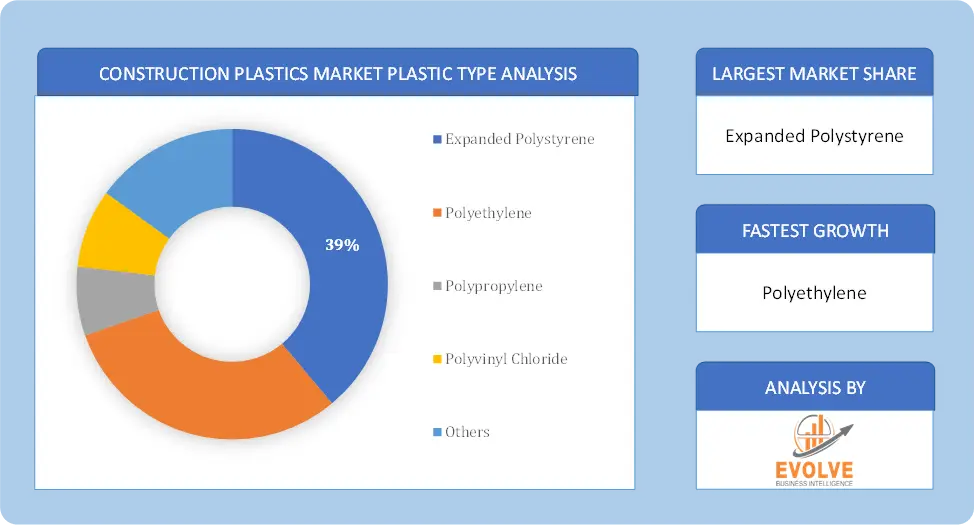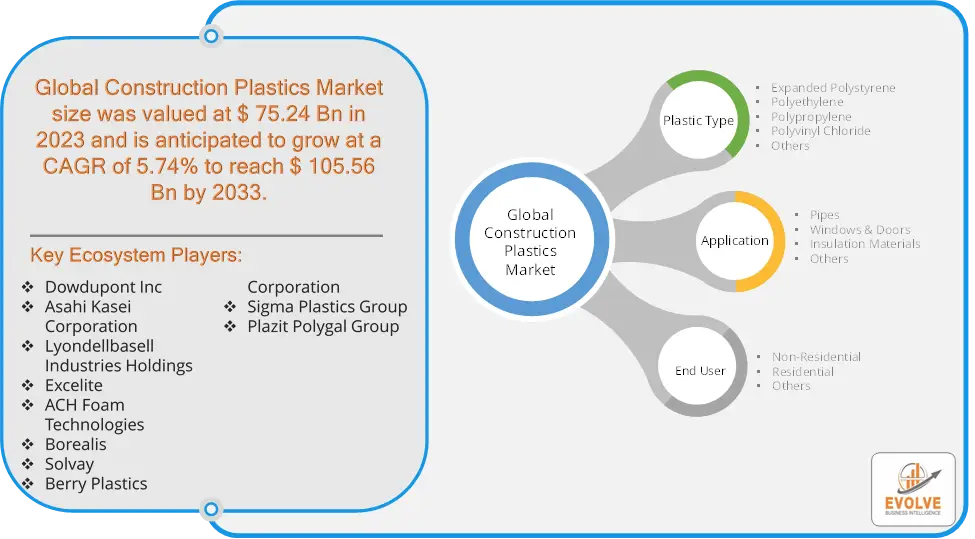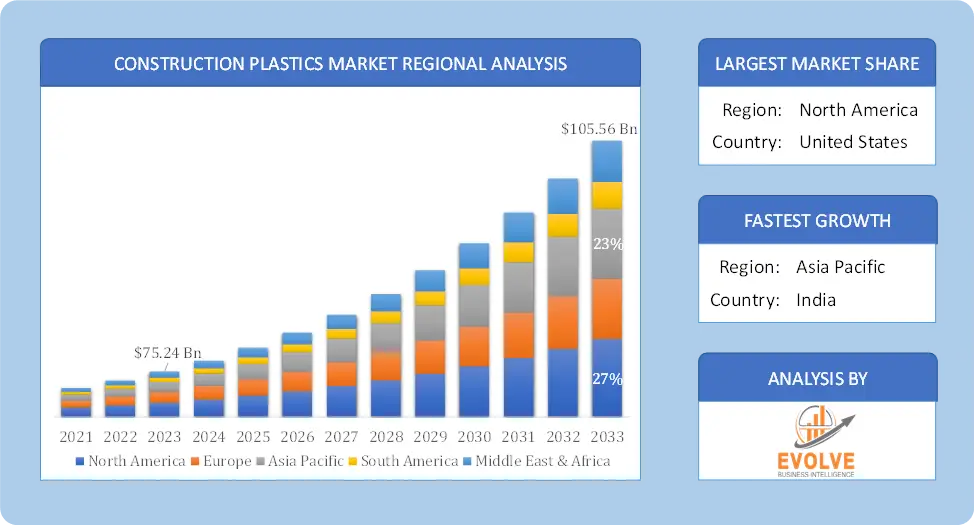Construction Plastics Market Analysis and Global Forecast 2023-2033
$ 1,390.00 – $ 5,520.00Price range: $ 1,390.00 through $ 5,520.00
Construction Plastics Market Research Report: Information By Plastic Type (Expanded Polystyrene, Polyethylene, Polypropylene, Polyvinyl Chloride, Others), By Application (Pipes, Windows & Doors, Insulation Materials, Others), By End-User (Non-Residential, Residential, Others) and by Region — Forecast till 2033
Page: 169
Construction Plastics Market Overview
The Construction Plastics Market Size is expected to reach USD 105.56 Billion by 2033. The Construction Plastics Market industry size accounted for USD 75.24 Billion in 2023 and is expected to expand at a compound annual growth rate (CAGR) of 5.74% from 2023 to 2033. The Construction Plastics Market refers to the global industry involved in the production, distribution, and application of plastic materials in construction projects. This market includes a wide range of plastic products used for various construction purposes, such as pipes, cables, flooring, insulation, windows, doors, and roofing. Construction plastics are valued for their durability, lightweight nature, cost-effectiveness, and versatility.
The Construction Plastics Market is expected to continue its growth trajectory, driven by technological advancements, increasing construction activities, and a focus on sustainable materials.
Global Construction Plastics Market Synopsis
The COVID-19 pandemic had a significant impact on the Construction Plastics Market. The pandemic caused temporary closures of manufacturing facilities due to lockdowns and restrictions, leading to delays in production. With a slowdown in construction activities, the demand for construction plastics declined, impacting revenue for manufacturers and suppliers. The pandemic heightened awareness of hygiene and health, leading to increased interest in antimicrobial and easy-to-clean plastic materials used in construction. The crisis accelerated the adoption of digital technologies and innovations in the construction industry, including advanced plastic materials and construction methods. The industry adapted to new norms, including remote working and virtual collaboration, which led to increased efficiency and new opportunities for plastic materials in construction. There is a growing emphasis on sustainable and smart construction solutions, driving innovation in plastic materials and their applications. The long-term growth potential of the Construction Plastics Market remains strong, supported by ongoing urbanization, infrastructure development, and technological advancements.
Construction Plastics Market Dynamics
The major factors that have impacted the growth of Construction Plastics Market are as follows:
Drivers:
Ø Technological Advancements
Advances in plastic technology, including the development of high-performance and specialty plastics, enhance their applicability in construction. Innovations in production techniques lead to more efficient manufacturing and better-quality plastic products. Plastics allow for creative and flexible designs in building construction, including complex shapes and unique aesthetics. Plastics can be easily customized for specific applications, providing versatility in design and functionality. Rising disposable incomes and changing lifestyles drive the demand for new housing and renovation projects. The expansion of commercial and industrial sectors creates demand for construction plastics in various applications.
Restraint:
- Perception of Fluctuating Raw Material Prices and High Initial Costs
The prices of raw materials used in plastic production, such as crude oil and natural gas, can fluctuate significantly, affecting the cost and availability of construction plastics. Advanced and specialty plastic materials often require higher initial investments compared to traditional materials, which may deter some stakeholders from adopting them. The presence of competitive materials, such as advanced composites or green building materials, can impact the market share of construction plastics. Intense competition among plastic manufacturers can lead to price wars and reduced profit margins.
Opportunity:
⮚ Sustainability and Eco-Friendly Solutions
Increasing demand for sustainable construction materials creates opportunities for recycled and eco-friendly plastics. Developing high-performance recycled plastics can attract environmentally-conscious customers. Innovations in biodegradable plastics offer a sustainable alternative to traditional plastics, reducing environmental impact and appealing to green building standards. Continued investment in infrastructure projects, including roads, bridges, and public facilities, creates significant demand for durable and versatile plastic materials. Expanding urban populations and increasing construction activities offer opportunities for plastics in various building applications.
Construction Plastics Market Segment Overview
By Plastic Type
 Based on Plastic Type, the market is segmented based on Expanded Polystyrene, Polyethylene, Polypropylene, Polyvinyl Chloride and Others. The Polyvinyl chloride segment dominant the market. Polyvinyl chloride plastic is widely used in the construction applications such as pipes, cables, flooring, window profiles, and roofing. PVC enhances the quality, cost-effectiveness, and safety of the construction materials, and also, have a less environmental effect, as compared to other construction plastics such as acrylic, composites, polypropylene, and other plastics. Polyvinyl chloride exhibits properties, such as thermal conductivity, scratch resistance, durability, insulation, flexibility, and design freedom. Thus, the growing demand for PVC plastic, in construction sector, will drive the demand for construction plastics market.
Based on Plastic Type, the market is segmented based on Expanded Polystyrene, Polyethylene, Polypropylene, Polyvinyl Chloride and Others. The Polyvinyl chloride segment dominant the market. Polyvinyl chloride plastic is widely used in the construction applications such as pipes, cables, flooring, window profiles, and roofing. PVC enhances the quality, cost-effectiveness, and safety of the construction materials, and also, have a less environmental effect, as compared to other construction plastics such as acrylic, composites, polypropylene, and other plastics. Polyvinyl chloride exhibits properties, such as thermal conductivity, scratch resistance, durability, insulation, flexibility, and design freedom. Thus, the growing demand for PVC plastic, in construction sector, will drive the demand for construction plastics market.
By Application
Based on Application, the market segment has been divided into Pipes, Windows & Doors, Insulation Materials and Others. The pipes segment dominated the construction market, owing to properties, such as durability, corrosion resistance, and cost efficiency. Plastics are preferred in pipes for transmission of fluids and various substances. The segment is estimated to maintain its dominance during the forecast period as well.
By End User
Based on End User, the market segment has been divided into Non-Residential, Residential and Others. The Non-Residential segment dominant the market. Non-residential construction sectors can use construction plastics in showrooms, manufacturing facilities, hospitals, retail establishments, and other places. The market will grow as a result of growing investments in non-residential construction.
Global Construction Plastics Market Regional Analysis
Based on region, the global Construction Plastics Market has been divided into North America, Europe, Asia-Pacific, the Middle East & Africa, and Latin America. North America is projected to dominate the use of the Construction Plastics Market followed by the Asia-Pacific and Europe regions.
 Construction Plastics North America Market
Construction Plastics North America Market
North America holds a dominant position in the Construction Plastics Market. The U.S. represents a significant portion of the North American market, driven by extensive construction activities across residential, commercial, and infrastructure sectors. High adoption of advanced technologies and materials in construction, including specialty plastics. Emphasis on sustainable construction practices and adherence to green building standards and high demand for new housing and commercial spaces due to population growth and urban expansion.
Construction Plastics Asia-Pacific Market
The Asia-Pacific region has indeed emerged as the fastest-growing market for the Construction Plastics Market industry. China is the largest market for construction plastics in Asia-Pacific, driven by extensive infrastructure and urban development. Rapid urbanization and large-scale construction projects fuel demand for various plastic materials. India is an emerging market with increasing construction activities and a growing demand for construction plastics and significant focus on infrastructure development and urbanization.
Competitive Landscape
The global Construction Plastics Market is highly competitive, with numerous players offering a wide range of software solutions. The competitive landscape is characterized by the presence of established companies, as well as emerging startups and niche players. To increase their market position and attract a wide consumer base, the businesses are employing various strategies, such as product launches, and strategic alliances.
Prominent Players:
- Dowdupont Inc
- Asahi Kasei Corporation
- Lyondellbasell Industries Holdings
- Excelite
- ACH Foam Technologies
- Borealis
- Solvay
- Berry Plastics Corporation
- Sigma Plastics Group
- Plazit Polygal Group
Key Development
In January 2024, Based on information from the public works department, the UP state government (India) improved and built 813 km of roads using bitumen and plastic trash, particularly single-use plastic. Through creative initiative, 466 roads and pathways have been upgraded overall. “This procedure promotes the appropriate disposal of waste made by single-use plastics.
Scope of the Report
Global Construction Plastics Market, by Plastic Type
- Expanded Polystyrene
- Polyethylene
- Polypropylene
- Polyvinyl Chloride
- Others
Global Construction Plastics Market, by Application
- Pipes
- Windows & Doors
- Insulation Materials
- Others
Global Construction Plastics Market, by End User
- Non-Residential
- Residential
- Others
Global Construction Plastics Market, by Region
- North America
- US
- Canada
- Mexico
- Europe
- UK
- Germany
- France
- Italy
- Spain
- Benelux
- Nordic
- Rest of Europe
- Asia Pacific
- China
- Japan
- South Korea
- Indonesia
- Austalia
- Malaysia
- India
- Rest of Asia Pacific
- South America
- Brazil
- Argentina
- Rest of South America
- Middle East & Africa
- Saudi Arabia
- UAE
- Egypt
- South Africa
- Rest of Middle East & Africa
| Parameters | Indicators |
|---|---|
| Market Size | 2033: $607.2 Billion |
| CAGR | 4.41% CAGR (2023-2033) |
| Base year | 2022 |
| Forecast Period | 2023-2033 |
| Historical Data | 2021 |
| Report Coverage | Revenue Forecast, Competitive Landscape, Growth Factors, and Trends |
| Key Segmentations | Plastic Type, Application, End User |
| Geographies Covered | North America, Europe, Asia-Pacific, Latin America, Middle East, Africa |
| Key Vendors | Dowdupont Inc, Asahi Kasei Corporation, Lyondellbasell Industries Holdings, Excelite, ACH Foam Technologies, Borealis, Solvay, Berry Plastics Corporation, Sigma Plastics Group and Plazit Polygal Group |
| Key Market Opportunities | • Sustainability and Eco-Friendly Solutions • Growing Urbanization and Infrastructure Development |
| Key Market Drivers | • Technological Advancements • Demand for Modern and Innovative Designs |
REPORT CONTENT BRIEF:
- High-level analysis of the current and future Construction Plastics Market trends and opportunities
- Detailed analysis of current market drivers, restraining factors, and opportunities in the future
- Construction Plastics Market historical market size for the year 2021, and forecast from 2023 to 2033
- Construction Plastics Market share analysis at each product level
- Competitor analysis with detailed insight into its product segment, Government & Defense strength, and strategies adopted.
- Identifies key strategies adopted including product launches and developments, mergers and acquisitions, joint ventures, collaborations, and partnerships as well as funding taken and investment done, among others.
- To identify and understand the various factors involved in the global Construction Plastics Market affected by the pandemic
To provide a detailed insight into the major companies operating in the market. The profiling will include the Government & Defense health of the company’s past 2-3 years with segmental and regional revenue breakup, product offering, recent developments, SWOT analysis, and key strategies.
Press Release

Global Pharmaceutical Manufacturing Market to Reach $1.38 Trillion by 2035 with 7.35% CAGR, New Research Shows

The Global Mammography Market Is Estimated To Record a CAGR of Around 10.29% During The Forecast Period

Glue Stick Market to Reach USD 2.35 Billion by 2034

Podiatry Service Market to Reach USD 11.88 Billion by 2034

Microfluidics Technology Market to Reach USD 32.58 Billion by 2034

Ferric Chloride Market to Reach USD 10.65 Billion by 2034

Family Practice EMR Software Market to Reach USD 21.52 Billion by 2034

Electric Hairbrush Market to Reach USD 15.95 Billion by 2034

Daily Bamboo Products Market to Reach USD 143.52 Billion by 2034

Cross-border E-commerce Logistics Market to Reach USD 112.65 Billion by 2034
Frequently Asked Questions (FAQ)
What is the study period of this market?
The study period of the global Construction Plastics Market is 2021- 2033
What is the growth rate of the global Construction Plastics Market?
The global Construction Plastics Market is growing at a CAGR of 4.41% over the next 10 years
Which region has the highest growth rate in the market of Construction Plastics Market?
Asia Pacific is expected to register the highest CAGR during 2023-2033
Which region has the largest share of the global Construction Plastics Market?
North America holds the largest share in 2022
Who are the key players in the global Construction Plastics Market?
Dowdupont Inc, Asahi Kasei Corporation, Lyondellbasell Industries Holdings, Excelite, ACH Foam Technologies, Borealis, Solvay, Berry Plastics Corporation, Sigma Plastics Group and Plazit Polygal Group are the major companies operating in the market
Do you offer Post Sale Support?
Yes, we offer 16 hours of analyst support to solve the queries
Do you sell particular sections of a report?
Yes, we provide regional as well as country-level reports. Other than this we also provide a sectional report. Please get in contact with our sales representatives
Table of Content
Chapter 1. Executive Summary Chapter 2. Scope Of The Study 2.1. Market Definition 2.2. Scope Of The Study 2.2.1. Objectives of Report Chapter 3. Evolve BI Methodology Chapter 4. Market Insights and Trends 4.1. Supply/ Value Chain Analysis 4.2. Porter’s Five Forces Analysis 4.2.1. Threat Of New Entrants 4.2.2. Bargaining Power Of Buyers 4.2.3. Bargaining Power Of Suppliers 4.2.4. Threat Of Substitutes 4.2.5. Industry Rivalry 4.3. Impact of COVID-19 on Construction Plastics Market 4.3.1. Impact on Market Size 4.3.2. End User Trend, Preferences, and Budget Impact 4.3.3. Regulatory Framework/Government Policies 4.3.4. Key Players Strategy to Tackle Negative Impact 4.3.5. Opportunity Window Chapter 5. Market Dynamics 5.1. Introduction 5.2. DRO Analysis 5.2.1. Drivers 5.2.2. Restraints 5.2.3. Opportunities Chapter 6. Global Construction Plastics Market, By Plastic Type 6.1. Introduction 6.2. Expanded Polystyrene 6.3. Polyethylene 6.4. Polypropylene 6.5. Polyvinyl Chloride 6.6. Others Chapter 7. Global Construction Plastics Market, By Application 7.1. Introduction 7.2. Pipes 7.3. Windows & Doors 7.4. Insulation Materials 7.5. Others Chapter 8. Global Construction Plastics Market, By End-User 8.1. Introduction 8.2. Non-Residential 8.3. Residential 8.4. Others Chapter 9. Global Construction Plastics Market, By Region 9.1. Introduction 9.2. North America 9.2.1. Introduction 9.2.2. Driving Factors, Opportunity Analyzed and Key Trends 9.2.3. Market Size and Forecast, By Country, 2020 - 2028 9.2.4. Market Size and Forecast, By Plastic Type, 2020 - 2028 9.2.5. Market Size and Forecast, By Application, 2020 - 2028 9.2.6. Market Size and Forecast, By End-User, 2020 - 2028 9.2.7. US 9.2.7.1. Introduction 9.2.7.2. Driving Factors, Opportunity Analyzed and Key Trends 9.2.7.3. Market Size and Forecast, By Plastic Type, 2020 - 2028 9.2.7.4. Market Size and Forecast, By Application, 2020 - 2028 9.2.7.5. Market Size and Forecast, By End-User, 2020 - 2028 9.2.8. Canada 9.2.8.1. Introduction 9.2.8.2. Driving Factors, Opportunity Analyzed and Key Trends 9.2.8.4. Market Size and Forecast, By Plastic Type, 2020 - 2028 9.2.8.5. Market Size and Forecast, By Application, 2020 - 2028 9.2.8.6. Market Size and Forecast, By End-User, 2020 - 2028 9.3. Europe 9.3.1. Introduction 9.3.2. Driving Factors, Opportunity Analyzed and Key Trends 9.3.3. Market Size and Forecast, By Country, 2020 - 2028 9.3.4. Market Size and Forecast, By Plastic Type, 2020 - 2028 9.3.5. Market Size and Forecast, By Application, 2020 - 2028 9.3.6. Market Size and Forecast, By End-User, 2020 - 2028 9.3.7. Germany 9.3.7.1. Introduction 9.3.7.2. Driving Factors, Opportunity Analyzed and Key Trends 9.3.7.3. Market Size and Forecast, By Plastic Type, 2020 - 2028 9.3.7.4. Market Size and Forecast, By Application, 2020 - 2028 9.3.7.5. Market Size and Forecast, By End-User, 2020 - 2028 9.3.8. France 9.3.8.1. Introduction 9.3.8.2. Driving Factors, Opportunity Analyzed and Key Trends 9.3.8.3. Market Size and Forecast, By Plastic Type, 2020 - 2028 9.3.8.4. Market Size and Forecast, By Application, 2020 - 2028 9.3.8.5. Market Size and Forecast, By End-User, 2020 - 2028 9.3.9. UK 9.3.9.1. Introduction 9.3.9.2. Driving Factors, Opportunity Analyzed and Key Trends 9.3.9.3. Market Size and Forecast, By Plastic Type, 2020 - 2028 9.3.9.4. Market Size and Forecast, By Application, 2020 - 2028 9.3.9.5. Market Size and Forecast, By End-User, 2020 - 2028 9.3.10. Italy 9.3.10.1. Introduction 9.3.10.2. Driving Factors, Opportunity Analyzed and Key Trends 9.3.10.3. Market Size and Forecast, By Plastic Type, 2020 - 2028 9.3.10.4. Market Size and Forecast, By Application, 2020 - 2028 9.3.10.5. Market Size and Forecast, By End-User, 2020 - 2028 9.3.11. Rest Of Europe 9.3.11.1. Introduction 9.3.11.2. Driving Factors, Opportunity Analyzed and Key Trends 9.3.11.3. Market Size and Forecast, By Plastic Type, 2020 - 2028 9.3.11.4. Market Size and Forecast, By Application, 2020 - 2028 9.3.11.5. Market Size and Forecast, By End-User, 2020 - 2028 9.4. Asia-Pacific 9.4.1. Introduction 9.4.2. Driving Factors, Opportunity Analyzed and Key Trends 9.4.3. Market Size and Forecast, By Country, 2020 - 2028 9.4.4. Market Size and Forecast, By Plastic Type, 2020 - 2028 9.4.5. Market Size and Forecast, By Application, 2020 - 2028 9.4.7. Market Size and Forecast, By End-User, 2020 - 2028 9.4.8. China 9.4.8.1. Introduction 9.4.8.2. Driving Factors, Opportunity Analyzed and Key Trends 9.4.8.3. Market Size and Forecast, By Plastic Type, 2020 - 2028 9.4.8.4. Market Size and Forecast, By Application, 2020 - 2028 9.4.8.5. Market Size and Forecast, By End-User, 2020 - 2028 9.4.9. India 9.4.9.1. Introduction 9.4.9.2. Driving Factors, Opportunity Analyzed and Key Trends 9.4.9.3. Market Size and Forecast, By Plastic Type, 2020 - 2028 9.4.9.4. Market Size and Forecast, By Application, 2020 - 2028 9.4.9.5. Market Size and Forecast, By End-User, 2020 - 2028 9.4.10. Japan 9.4.10.1. Introduction 9.4.10.2. Driving Factors, Opportunity Analyzed and Key Trends 9.4.10.3. Market Size and Forecast, By Plastic Type, 2020 - 2028 9.4.10.4. Market Size and Forecast, By Application, 2020 - 2028 9.4.10.5. Market Size and Forecast, By End-User, 2020 - 2028 9.4.11. South Korea 9.4.11.1. Introduction 9.4.11.2. Driving Factors, Opportunity Analyzed and Key Trends 9.4.11.3. Market Size and Forecast, By Plastic Type, 2020 - 2028 9.4.11.4. Market Size and Forecast, By Application, 2020 - 2028 9.4.11.5. Market Size and Forecast, By End-User, 2020 - 2028 9.4.12. Rest Of Asia-Pacific 9.4.11.1. Introduction 9.4.12.2. Driving Factors, Opportunity Analyzed and Key Trends 9.4.12.3. Market Size and Forecast, By Plastic Type, 2020 - 2028 9.4.12.4. Market Size and Forecast, By Application, 2020 - 2028 9.4.12.5. Market Size and Forecast, By End-User, 2020 - 2028 9.5. Rest Of The World (RoW) 9.5.1. Introduction 9.5.2. Driving Factors, Opportunity Analyzed and Key Trends 9.5.3. Market Size and Forecast, By Plastic Type, 2020 - 2028 9.5.4. Market Size and Forecast, By Application, 2020 - 2028 9.5.5. Market Size and Forecast, By End-User, 2020 - 2028 9.5.6. Market Size and Forecast, By Region, 2020 - 2028 9.5.7. South America 9.5.7.1. Introduction 9.5.7.2. Driving Factors, Opportunity Analyzed and Key Trends 9.5.7.3. Market Size and Forecast, By Plastic Type, 2020 - 2028 9.5.7.4. Market Size and Forecast, By Application, 2020 - 2028 9.5.7.5. Market Size and Forecast, By End-User, 2020 - 2028 9.5.8. Middle East & Africa 9.5.8.1. Introduction 9.5.8.2. Driving Factors, Opportunity Analyzed and Key Trends 9.5.8.3. Market Size and Forecast, By Plastic Type, 2020 - 2028 9.5.8.4. Market Size and Forecast, By Application, 2020 - 2028 9.5.8.5. Market Size and Forecast, By End-User, 2020 - 2028 Chapter 10. Competitive Landscape 10.1. Introduction 10.2. Vendor Share Analysis, 2020/Key Players Positioning 2020 Chapter 11. Company Profiles 11.1. Dowdupont Inc 11.1.1. Business Overview 11.1.2. Financial Analysis 11.1.3. Product Portfolio 11.1.4. Recent Development and Strategies Adopted 11.1.5. SWOT Analysis 11.2. Asahi Kasei Corporation 11.2.1. Business Overview 11.2.2. Financial Analysis 11.2.3. Product Portfolio 11.2.4. Recent Development and Strategies Adopted 11.2.5. SWOT Analysis 11.3. Lyondellbasell Industries Holdings 11.3.1. Business Overview 11.3.2. Financial Analysis 11.3.3. Product Portfolio 11.3.4. Recent Development and Strategies Adopted 11.3.5. SWOT Analysis 11.4. Excelite 11.4.1. Business Overview 11.4.2. Financial Analysis 11.4.3. Product Portfolio 11.4.4. Recent Development and Strategies Adopted 11.4.5. SWOT Analysis 11.5. ACH Foam Technologies 11.5.1. Business Overview 11.5.2. Financial Analysis 11.5.3. Product Portfolio 11.5.4. Recent Development and Strategies Adopted 11.5.5. SWOT Analysis 11.6. Borealis 11.6.1. Business Overview 11.6.2. Financial Analysis 11.6.3. Product Portfolio 11.6.4. Recent Development and Strategies Adopted 11.6.5. SWOT Analysis 11.7. Solvay 11.7.1. Business Overview 11.7.2. Financial Analysis 11.7.3. Product Portfolio 11.7.4. Recent Development and Strategies Adopted 11.7.5. SWOT Analysis 11.8. Berry Plastics Corporation 11.8.1. Business Overview 11.8.2. Financial Analysis 11.8.3. Product Portfolio 11.8.4. Recent Development and Strategies Adopted 11.8.5. SWOT Analysis 11.9. Sigma Plastics Group 11.9.1. Business Overview 11.9.2. Financial Analysis 11.9.3. Product Portfolio 11.9.4. Recent Development and Strategies Adopted 11.9.5. SWOT Analysis 11.10. Plazit Polygal Group 11.10.1. Business Overview 11.10.2. Financial Analysis 11.10.3. Product Portfolio 11.9.4. Recent Development and Strategies Adopted 11.9.5. SWOT Analysis Chapter 12. Key Takeaways
Connect to Analyst
Research Methodology








